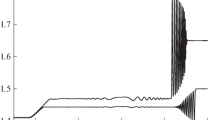Abstract
A theoretical model is presented for describing the motion of a deformable cell encapsulating a Newtonian fluid and enclosed by an elastic membrane in tube flow. In the mathematical formulation, the interior and exterior hydrodynamics are coupled with the membrane mechanics by means of surface equilibrium equations, and the problem is formulated as a system of integral equations for the interfacial velocity, the disturbance tube-wall traction, and the pressure difference across the two ends to the tube due to the presence of the cell. Numerical solutions obtained by a boundary-element method are presented for flow in a cylindrical tube with a circular cross-section, cytoplasm viscosity equal to the ambient fluid viscosity, and cells positioned sufficiently far from the tube wall so that strong lubrication forces do not arise. In the numerical simulations, cells with spherical, oblate ellipsoidal, and biconcave unstressed shapes enclosed by membranes that obey a neo-Hookean constitutive equation are considered. Spherical cells are found to slowly migrate toward the tube centerline at a rate that depends on the mean flow velocity, whereas oblate and biconcave cells are found to develop parachute and slipper-like shapes, respectively, from axisymmetric and more general initial orientations.
Similar content being viewed by others
References
Brenner, B. Pressure drop due to the motion of neutrally buoyant particles in duct flows J. Fluid Mech. 43: 4641-660, 1970.
Coulliette, C., and C. Pozrikidis. Motion of liquid drops through tubes J. Fluid Mech. 358: 1-28, 1998.
Diaz, A., and D. BarthéBiesel. Entrance of a bioartificial capsule in a pore Comput. Mod. Eng. Sc. 3: 321-337, 2002.
Evans, E. A., and Y. C. Fung. Improved measurements of the erythrocyte geometry Microvasc. Res. 4: 335-347, 1972.
Goldsmith, H. L., and S. G. Mason. The microrheology of dispersions. Rheology, Theory and Applications, 4:85–250 (1967).
Greenstein, T., and J. Happel. Theoretical study of the slow motion of a sphere and a fluid in a cylindrical tube. J. Fluid Mech. 34:705–710, 1968.
Hsu, R., and T. W. Secomb. Motion of nonaxisymmetric red blood cells in cylindrical capillaries J. Biomech. Eng. 111: 147-151, 1989.
Kennedy, M., C. Pozrikidis, and R. Skalak. Motion and deformation of liquid drops, and the rheology of dilute emulsions in shear flow. Computers & Fluids 23: 251-278, 1994.
Leyrat-Maurin, A., and D. Barthés-Biesel. Motion of a deformable capsule through a hyperbolic constriction. J. Fluid Mech. 279:135–163, 1994.
Magnaudet, J., S. Takagi, and D. Legendre. Drag, deformation and lateral migration of a buoyant drop moving near a wall J. Fluid Mech. 476: 115-157, 2003.
Özkaya, N. Viscous Flow of Particles in Tubes: Lubrication Theory and Finite Element Models. Doctoral Dissertation, Columbia University, New York, 1986.
Pozrikidis, C. Boundary Integral and Singularity Methods for Linearized Viscous Flow. Cambridge: Cambridge University Press, 1992.
Pozrikidis, C. Introduction to Theoretical and Computational Fluid Dynamics. New York: Oxford University Press, 1997.
Pozrikidis, C. A Practical Guide to Boundary-Element Methods with the Software Library BEMLIB. Boca Raton: Chapman & HALL/CRC, 2002.
Pozrikidis, C. Numerical simulation of the flow-induced deformation of red-blood cells Ann. Biomed. Eng. 31: 1-12, 2003.
Pozrikidis, C. Axisymmetric motion of a file of red blood cells through capillaries. Phys. Fluids Accepted.
Pozrikidis, C. Computation of Stokes flow due to particle motion in a tube. J. Eng. Math. Submitted.
Pries, A. R., D. Neuhaus, and P. Gaetgens. Blood viscosity in tube flow: Dependence on diameter and hematocrit. Am. J. Physiol. 263:H1770–H1778, 1992.
Quéguiner, C., and D. Barthés-Biesel. Axisymmetric motion of capsules through cylindrical channels. J. Fluid Mech. 348:349–376, 1997.
Secomb, T. W. Flow-dependent rheological properties of blood in capillaries Microvasc. Res. 34: 46-58, 1987
Secomb, T. W. Red blood cell mechanics and capillary blood rheology. Cell Biophys. 18: 231-251, 1992.
Secomb, T. W. Mechanics of blood flow in the microcirculation. In: Biological Fluid Dynamics, edited by C. P. Ellington and T. J. Pedley. Cambridge: Cambridge University Press, 1995, pp. 305–321.
Secomb, T. W. Mechanics of red blood cells and blood flow in narrow tubes. In: Modeling and Simulation of Capsules and Biological Cells, edited by C. Pozrikidis. Boca Raton: Chapman & Hall/CRC, 2003.
Secomb, T. W., and J. F. Gross. Flow of red blood cells in narrow capillaries: Role of membrane tension Int. J. Microcirc.: Clin. Exp. 2: 229-240, 1983
Secomb, T. W., and R. Hsu. Analysis of red blood cell motion through cylindrical micropores: Effects of cell properties Biophys. J. 171: 1095-1101, 1996.
Secomb, T. W., R. Hsu, and A. R. Pries. Motion of red blood cells in a capillary with an endothelial surface layer: Effect of flow velocity. Am. J. Physiol. Heart Circ. Physiol. 281:H629–H636, 2001.
Secomb, T. W., R. Skalak, N. Özkaya, and J. F. Gross. Flow of axisymmetric red blood cells in narrow capillaries J. Fluid Mech. 163: 405-423, 1986.
Skalak, R., and P. I. Branemark. Deformation of red blood cells in capillaries Science 164: 283-287, 1969.
Skalak, R., N. Özkaya, and T. C. Skalak. Biofluid mechanics Annu. Rev. Fluid Mech. 21: 167-204, 1989.
Skalak. R., and H. Tözeren. Flow mechanics in the microcirculation. In: Mathematics of Microcirculation Phenomena, edited by J. F. Gross and A. Popel. New York: Raven Press, 1980, 17-40.
Skalak, R., A. Tözeren, P. R. Zarda, and S. Chien. Strain energy function of red blood cell membranes Biophys. J. 13: 245-264, 1973.
Zarda, P. R., S. Chien, and R. Skalak,. Interaction of viscous incompressible fluid with an elastic body. In: Computational Methods for Fluid-Solid Interaction Problems, edited by T. Belytschko and T. L. Geers, New York: American Society of Mechanical Engineers, 1977, 65–82.
Author information
Authors and Affiliations
Corresponding author
Rights and permissions
About this article
Cite this article
Pozrikidis, C. Numerical Simulation of Cell Motion in Tube Flow. Ann Biomed Eng 33, 165–178 (2005). https://doi.org/10.1007/s10439-005-8975-6
Received:
Accepted:
Issue Date:
DOI: https://doi.org/10.1007/s10439-005-8975-6



